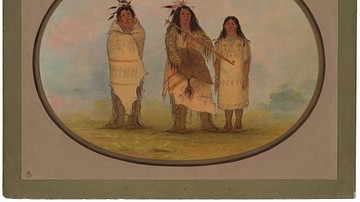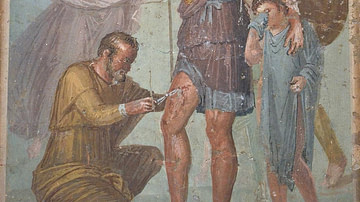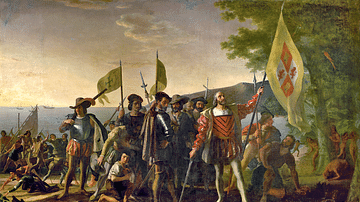The age of antibiotics began in September 1928, with the discovery of penicillin by Alexander Fleming (1881-1955), then a professor of bacteriology at St. Mary's Hospital in London. Previously there were no effective treatments against a range of bacterial infections from pneumonia to sepsis.
Penicillin became the basis for curing bacterial infections including smallpox, cholera, tuberculosis, scarlet fever, pneumonia, gonorrhea, meningitis, and diphtheria. Later antibiotics would form a class of medicines designed to combat, and cure, bacterial infections but also prevent the further growth of such infections.
Background
The use of fungi and molds, which contain antibacterial substances, to treat bacterial infections can be traced back to ancient cultures around the world, but these early attempts were unable to identify the component that provided the medicinal effect. Joseph Lister (1827-1912), an English surgeon and the "Father of antisepsis," recognized the antibacterial component of mold, but did not publish his findings. In the 1870s, Robert Koch (1843-1910), a German biologist, and Louis Pasteur (1825-1895) and Jules Francois Joubert (1834-1910), two French biologists, discovered the germ theory, which established that particular bacteria cause specific diseases. Additionally, they proved that the effects of introducing certain bacteria to various cultures inhibited the growth of more deadly bacteria.
The discovery of penicillin represented a turning point in medical history while Fleming would later be recognized by Time magazine as one of the most influential people of the 20th century:
When I woke up just after dawn on September 28, 1928 I certainly didn't plan to revolutionize all medicine by discovering the world's first antibiotic, or bacteria killer. But I suppose that is exactly what I did.
Alexander Fleming
Alexander Fleming joined the Royal Army Medical Corps during World War I (1914-18). Working primarily in hospitals located on the Western Front, Fleming was exposed to the horrific injuries suffered by troops, especially from explosions from artillery and mortars. As a result of those wounds, soldiers developed sepsis, often dying from that blood infection. Fleming began studying both the wounds and treatments used to combat infections. Fleming's research proved that the Lister approach, aka Lister Antisepsis System named after Joseph Lister who first applied the germ theory to wounds and surgery, which treated wounds with antiseptics like iodine and carbolic acid did not penetrate far enough into the deepest wounds, thus not killing all of the harmful bacteria. In fact, the Lister system contributed to higher casualty rates as the antiseptics also killed natural therapeutic characteristics. Fleming's findings about the Lister system and war wounds were published in a 1917 edition of the Lancet but largely ignored by most frontline doctors. Fleming recommended that the antiseptics be used with a higher-concentration saline solution to disinfect and wash out the deeper wounds.
After the war, Fleming returned to St. Mary's Hospital, where he continued his research into bacteria and treatments. In one experiment, in 1921, Fleming found that bacteria in the air contaminated one of his culture plates, but nasal mucus, when added to the culture, prohibited further growth of the bacteria. His additional experiments into antibacterial growth found that human tears, sputum, blood, semen, pus, and egg whites possessed similar properties preventing bacterial growth. Despite presentations before the Royal Society and a publication in the Proceedings of the Royal Society in May 1922, in which Fleming labeled the antibacterial property (lysozyme) found in the various tissues and secretions, Fleming's conclusions were ignored. Fleming's Nobel speech in 1945 referred back to his groundbreaking discovery of lysozyme, which, as he pointed out, was the first antibiotic discovered before penicillin.
Discovery
On 3 September 1928, Fleming returned home after vacationing in Scotland. Prior to his departure, Fleming left some uncovered petri dishes containing staphylococcus, the bacterium that causes sore throats, abscesses, and boils, on his workbench. In one of the dishes, Fleming noticed a mold (Penicillium notatum) growing, which was secreting an antibacterial substance around which there was an area surrounding the mold that was free of the bacteria although the bacteria were alive further away in the dish. He reached the conclusion that the mold killed the bacteria. Further experiments with the mold confirmed that it killed a variety of bacteria including streptococcus (a bacteria that causes strep throat, scarlet & rheumatic fevers, and necrotizing fasciitis aka flesh-eating bacteria) and meningococcus (meningitis) and diphtheria. Subsequently, on 7 March 1929, Fleming named the antibacterial mold penicillin. In June 1929, Fleming published a paper on his experiments in the British Journal of Experimental Pathology. The scientific community paid little attention to Fleming's research, the same lack of attention he received following a presentation of his findings at the Medical Research Club the previous February.
In both the lecture and paper Fleming admitted difficulty in producing a pure form of penicillin and an inability to produce the antibacterial in large quantities. Despite the little interest in Fleming's research throughout the 1930s, he continued to produce penicillin on a small scale. Fleming again offered his research at the Second International Congress of Microbiology in 1936 but again was dismissed, despite his suggestion that penicillin could be a powerful antibacterial against a whole range of infections. As late as 1941, the British Medical Journal downplayed the utility of penicillin.
Application & Trials
It would be a team of scientists at the Sir William Dunn School of Pathology at Oxford University who would overcome the obstacles encountered by Fleming. Cultivating, extracting, purifying, and storing the penicillin became the objectives of the research team. Edward Abraham (1913-1999) discovered the correct structure of penicillin while Norman Heatley (1911-2004) recommended re-introducing the antibacterial back into water thus changing its acidity. Both discoveries allowed producing sufficient quantities of penicillin so as to begin animal trials on penicillin's efficacy.
The initial tests were designed to determine the toxicity of penicillin. Rats, mice, rabbits, and cats were injected with penicillin after being exposed to various harmful bacteria; these tests proved the effectiveness of penicillin. Fortunately, the researchers did not use guinea pigs in the animal tests as penicillin was toxic to the animal. The guinea pigs' gut microbiome, or gut flora, contains bacteria, that live in its digestive tract, but combined with penicillin, it causes the animal to experience diarrhea and death. In May 1940, Howard Florey (1898-1968) and Ernst Chain (1906-1979) infected a group of mice with streptococcus. Half of the mice, that were left untreated, died from sepsis; the half treated with penicillin survived. Further trials using ever-increasing numbers of animals produced similar results.
Experiments on humans began as early as 1929 when Fleming attempted to cure a nasal infection but failed as the bacteria which caused the infection was not susceptible to penicillin. It would be one of Fleming's students, Cecil George Paine (1905-1994) who successfully used penicillin to treat and cure conjunctivitis in adults and children in November 1930. Stories abound about the early attempts to use penicillin to treat infections in humans. In September 1940, a police officer, Albert Alexander, scratched his face while working in his home garden. The injury resulted in him being struck with streptococci and staphylococci infections. The initial sulfur treatments did not work, and in February 1941, Florey and Chain received permission to treat Alexander with penicillin. Unfortunately, the doctors could not produce a sufficient quantity of the drug, resulting in Alexander's death in March 1941. Subsequent trials used children as they needed a lesser amount of penicillin; those experiments proved successful.
Mass Production & Consequences
The start of the Second World War (1939-45) necessitated that further work on producing penicillin in mass quantities relocate from London due to the London Blitz, the German bombing campaign on the city. The operations moved to Peoria, Illinois, in the United States where Florey was joined by Dr. Norman Heatley (1911-2004), an English biologist and biochemist. The United States and British governments along with US drug companies, hospitals, doctors, and scientists assisted cooperatively to increase the scale of production. The breakthrough occurred in the summer of 1943 when a lab assistant, Mary Hunt, brought a rotten cantaloupe covered with a "pretty, golden mold" (Penicillium chrysogenum) which produced significant amounts of the drug. Production of penicillin ramped up, resulting in levels of manufacturing that effectively treated all of the wounded soldiers who participated in the Normandy landings on D-Day in June 1944.
Penicillin was first introduced on a large scale during World War II, with tremendous success. During World War I, bacterial infections accounted for nearly 20% of all deaths; the rate dropped to less than 1% during WWII due to the use of penicillin. In the subsequent 80 years, medical health has been transformed by the life-saving effects of antibiotics. Not only has human health been positively affected but the pharmaceutical drug industry has also altered its methods of drug discovery, produced antibiotics on unimaginable scale since the early days, and the application of antibiotics in clinical settings has permanently altered humankind's approaches towards deadly diseases. In recent decades, human health and the use of antibiotics have been challenged by the rise of "superbugs", which have developed resistance to antibiotics. The overuse of the drugs, particularly in pediatric care, and the introduction of antibiotics into animal feed grains have contributed to this resistance phenomenon. Efforts are underway to reduce the use antibiotics for minor infections in humans, remove the drugs from the feed industry, and develop new forms of antibiotics to combat the resistant strains of harmful bacteria.
Much controversy in the decades since the discovery of penicillin has involved whom to give credit for its discovery and application. Alexander Fleming has received the greatest amount of credit for its discovery, however, it required the team of Florey, Chain, Heatly, and other members of the Oxford team to refine Fleming's discovery and devise a method for the large-scale production of the drug. In 1945, Fleming, Florey, and Chain shared the Nobel Prize in Medicine for their efforts. 45 years later, Heatley was awarded an honorary doctorate in medicine by the Nobel committee, a first in the history of the prize.
Nonetheless, life-saving antibiotics have now become an accepted fact of contemporary life. At the beginning of the 20th century, diseases such as smallpox, tuberculosis, cholera, pneumonia, and others contributed to high mortality rates around the globe, and life expectancy averaged 47 years for both men and women. Throughout the course of the century not only did antibiotics contribute to the sharp increase of average life expectancy to 78 years in the developed countries but non-communicable diseases, such as cancers, stroke, or heart disease, also replaced the earlier infectious diseases as the leading causes of death.
Penicillin permanently changed infectious disease research and therapeutic medicine. It transformed patient expectations and the structure of drug companies; it contributed new insights in microbiology, and, moreover it captured the public imagination as did few other scientific breakthroughs.
(Bennett, 163)














